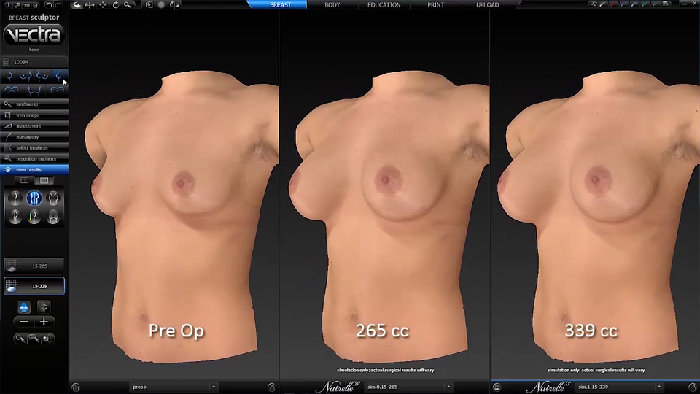Architects and designers have long used three dimensional imaging and computer software to plan and help clients visualize final results. Today, plastic surgeons are also using three dimensional imaging and computer software to plan and predict body renovations.
Undergoing plastic surgery can be both exciting and scary. Patients enter into surgery eager to improve their appearance, but there is almost always a bit of anxiety that accompanies the recovery as they wait to see the end result. Three dimensional imaging is one way plastic surgeons can ease that anxiety, helping patients visualize their results before they even undergo the procedure.
“Imaging started with rhinoplasty, because you could take a profile view and really show those changes,” explains board certified plastic surgeon Dr. Louis P. Bucky. “We’ve taken imaging from 17 years ago, when we were just doing noses, to the entire face, breasts and body contouring.”
Today, Dr. Bucky can’t imagine doing a breast surgery without the aid of computer imaging. Not only does it help his patients view their own body better than a mirror or a two dimensional picture can, but it also helps his patients visualize their potential outcome.
How We See Ourselves
Thirty years ago, people didn’t carry around cameras twenty-four hours a day. In today’s world, it is rare to find a person who doesn’t have their cell phone within reach. Cell phone cameras and the proliferation of selfies are changing the way we see ourselves.
“There’s a big emphasis on what I call central facial appearance,” says Bucky. “Lips, brows, noses, eyes, cheeks. No one is paying attention to the frame, to the jawline, to the temples and other areas.”
With the use of three dimensional imaging in his office, Dr. Bucky is able to help his patients take a step back and view a different version of themselves. They are no longer limited to the selfie angle. Instead of up close and head-on, they are able to themselves from every angle.
Accuracy of 3D Imaging Predictions
Rather than describing to patients how their appearance will change after surgery, Dr. Bucky is able to show patients what surgery will realistically accomplish. The simulated results are fantastic, but can patients realistically expect their plastic surgery outcome to deliver the same results as the computer predicts?
The answer depends on the surgeon. Experienced plastic surgeons like Dr. Bucky are able to reliably use three dimensional imaging to show patients the kind of results they can expect after surgery. “The resistance to imaging has always been that people were concerned about an implied result and an implied guarantee,” says Bucky. “With the improvements in imaging and the improvements in technique in surgery, if you can’t deliver what you’re going to say you’re going to deliver, then, that disconnect needs to fixed.”
Visualizing the results of surgery removes much of the potential for misunderstanding during the planning process. Instead of describing to a patient how they will look, surgeons can show the patient. Seeing results decreases anxiety and ensures both the patient and surgeon are on the same page with their expectations.
When it comes to breast surgery in particular, the computer is a valuable tool in the planning process. It not only measures current volume and dimensions of the breasts, but it can also provide the patient with an accurate view of changes in shape and dimension based on the implants they select. Patients can “plug in” different sizes or shapes of implants and view the predicted results. Patients also get a chance to see how the different implant choices change their body proportions overall as they view their body from many different angles.
Imaging And the Bigger Picture
Having a three dimensional image to view often opens up the conversation about other areas a patient may want to address at the time of surgery. A discussion about the breast may evolve to include the abdomen or the backside of the body. A conversation about the nose may broaden to include a discussion about options to improve the eyes or the cheeks as well.
3D Imaging Is Used for Planning:
- Facelifts & Fillers
- Rhinoplasty
- Breast Surgery
- Tummy Tucks
- Butt Lifts
“If you’re coming in for a tummy tuck, but you’re really not happy with what’s going on in the back, we can talk about about that as well,” says Bucky.
The image on the screen is a platform for conversation that allows the surgeon and patient to discuss and plan surgery with a bigger picture in mind.


















Facebook
Twitter
Instagram
YouTube
RSS